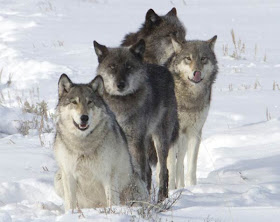 |
| Wolf 832 is on the right. Her mate, left, was killed by a hunter last month. Photo by Doug McLaughlin |
Back in the old days, when people first discovered Yellowstone, there were lots of gray wolves living there. But then settlers started coming to the area, and they shot the wolves because they didn't want them to kill their cattle and sheep. So by the 1930s, there were no more wolves. But in 1995 and 1996, about 30 wolves were brought from Canada to the Lamar Valley of Yellowstone. This was done to try to make the wildlife balance be more like it was in the 19th century. The wolves had babies, and more wolves were brought in later, and now there are 10 packs of wolves in the park.
Of course, wolves like to eat elk, so this has made the elk population smaller, which means there is more food for the elk that haven't been eaten by wolves. Also, trees such as cottonwoods, willows, and aspens are growing better because the elk don't eat all the new baby trees. There are more beavers now, more songbirds, and more fish. There are fewer coyotes, because the wolves see them as competitors for food and kill them. But fewer coyotes means more foxes. Also there are more carcasses for scavengers like ravens and bears.
So bringing back the wolves has made these things better. But sometimes the wolves go out of the park and kill cattle and sheep, which are easy to kill because they are in fenced areas. Ranchers depend on their livestock to make a living, so they don't want wolves eating all their animals. But wolves are just looking for a tasty meal. The government will pay a rancher for livestock that is killed by wolves, but the rancher has to find the kill right away, and there has to be enough of the animal left so that it is clear that a wolf killed it and not some other predator. Which makes it hard sometimes for the ranchers to get reimbursed for their losses.
Because the wolf population of Yellowstone has been growing, wolves have been taken off the endangered species list, which made it legal to hunt them. Wyoming was the last of the three states around the park where wolf hunting got okayed. Ranchers feel better and more tolerant of wolves now that wolves can be hunted, but other people think the hunting is "too aggressive." At least that's what Suzanne Stone, who is a wolf expert from Defenders of Wildlife says. She also says that the wolf reintroduction program is being threatened.
 |
| Wolf 832 on the left. Photo by Doug McLaughlin |
Since the wolf hunting season opened this fall in Wyoming, eight wolves wearing GPS collars have been killed. Nobody knows exactly how many wolves without collars have been killed, but it might have been something like 50. Last Friday, the Humane Society of the United States and the Fund for Animals filed a lawsuit to try to make the U.S. Fish and Wildlife Service put wolves back on the endangered species list in Wyoming.
Jonathan Lovvorn, of the HSUS, said in a statement that "The agency's decision to strip Wyoming wolves of federal protection is biologically reckless and contrary to the requirements of the Endangered Species Act. Wyoming's regressive wolf management plan is reminiscent of a time when bounties paid by state and federal governments triggered mass killings that nearly exterminated wolves from the lower 48 states."
 |
| Wolves from the Lamar Canyon pack. ©Meg Sommers |
Oh, and if you want to learn more about the subject of wolves in Yellowstone, including all the issues that biologists and ranchers are dealing with, you should read this really interesting article in American Scientist magazine.

No comments:
Post a Comment